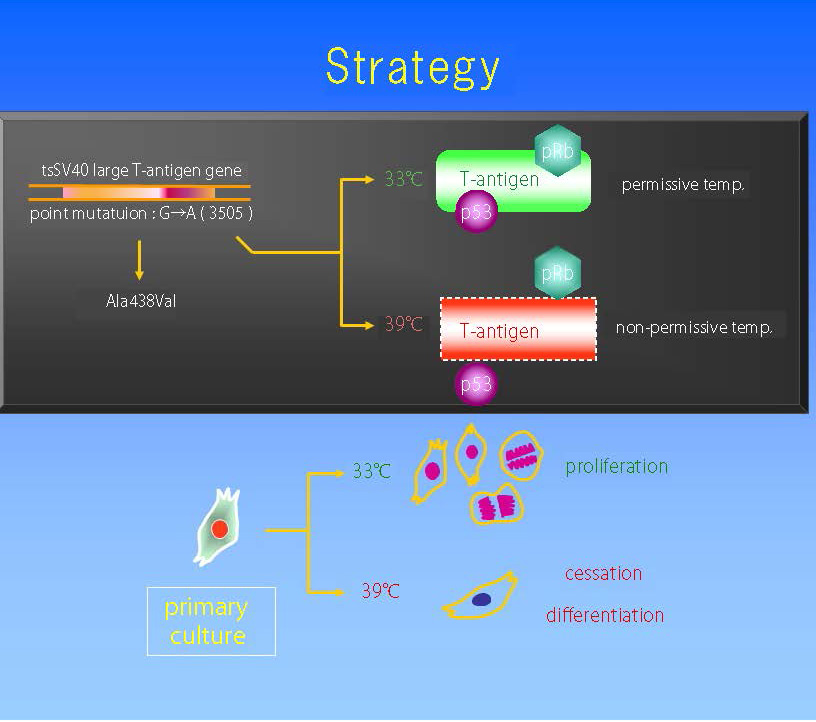(株)ファクト http://fact-sv40.world.coocan.jp/
In vitro細胞培養系は,細胞の特異的機能を詳細に検討することができる非常に有用な実験系です.しかしながら,正常の細胞機能を保持した細胞系は少ないのが現状です.温度感受性 simian virus 40 (tsSV40) 大型T抗原は,温度感受性のタンパク質で,許容温度33℃ではタンパク質が正常に機能し癌抑制遺伝子p53やpRb (レチノブラストーマタンパク質) と結合し,これらの癌抑制遺伝子の働きを阻害します.一方,非許容温度39℃ではタンパク質が変性・分解されるので,癌抑制遺伝子の働きを阻害することができません.この温度感受性タンパク質が発現する33℃では細胞は増殖しますが,39℃では増殖が抑制され,細胞の分化が誘導されます(図).

生体の種々の組織の機能保持細胞株を容易に樹立するために,このtsSV40大型T抗原遺伝子導入トランスジェニック (TG) マウスやTGラットが考案されました.これまでに本遺伝子導入TG動物から肝実質細胞,胃粘膜上皮細胞,腎尿細管細胞,血管平滑筋細胞,血管内皮細胞,骨髄ストローマ細胞,脂肪細胞,骨芽細胞,気道上皮細胞,結腸上皮細胞,精巣細胞,口腔上皮細胞など多数の組織から機能を保持した数多くの細胞株が樹立されました (1-5).我々は,これらの中で胃粘膜上皮細胞,気道上皮細胞,結腸上皮細胞,精巣細胞や口腔上皮細胞の樹立に貢献しました.これらの細胞を用いたin vitroモデルは,生理機能解析,薬のターゲット探索,組織の移植,薬の毒性評価など様々な方面の研究に応用可能です.さらに,これらを用いた研究は実験動物の代替法に繋がり動物倫理の観点からも価値のある研究と考えます.樹立した細胞株は,国内外の数多くの研究機関で使用され,研究成果が着実に増加しています (6-13等).
関連論文と総説:
1) Tabuchi Y. Characterization and application of a gastric surface mucous cell line GSM06 established from temperature-sensitive simian virus 40 large T-antigen transgenic mice. Jpn J Pharmacol. 2001 Feb;85(2):117-23. Review. PMID: 11286392
2) Obinata M. Possible applications of conditionally immortalized tissue cell lines with differentiation functions. Biochem Biophys Res Commun. 2001 Aug 31;286(4):667-72. Review. PMID: 11520047
3) Tabuchi Y. Development of cell model with specific functions and its application to the study of global gene expression. Yakugaku Zasshi. 2004 May;124(5):261-8. Review. PMID: 15118238
4) Obinata M. The immortalized cell lines with differentiation potentials: their establishment and possible application. Cancer Sci. 2007 Mar;98(3):275-83. Epub 2007 Jan 12. Review. PMID: 17233813
5) Tabuchi Y et al. Development of oral epithelial cell line ROE2 with differentiation potential from transgenic rats harboring temperature-sensitive simian virus40 large T-antigen gene. Exp Anim. 2014;63(1):31-44. PMID: 24521861
6) Matsumoto T et al. Hochuekkito, a Kampo (Traditional Japanese Herbal) Medicine, and its Polysaccharide Portion Stimulate G-CSF Secretion from Intestinal Epithelial Cells. Evid Based Complement Alternat Med. 2010 Sep;7(3):331-40. PMID: 18955322
7) Warita K et al. Microarray and gene ontology analyses reveal downregulation of DNA repair and apoptotic pathways in diethylstilbestrol-exposed testicular Leydig cells. J Toxicol Sci. 2012;37(2):287-95. PMID: 22467019
8) Nakajima A et al. Attenuation of indomethacin-induced gastric mucosal injury by prophylactic administration of sake yeast-derived thioredoxin. J Gastroenterol. 2012 Sep;47(9):978-87. PMID: 22402774
9) Takahashi T et al. Musashi-1 post-transcriptionally enhances phosphotyrosine-binding domain-containing m-Numb protein expression in regenerating gastric mucosa. PLoS One. 2013;8(1):e53540. PMID: 23308249
10) Tabuchi Y et al. Genes and gene networks involved in sodium fluoride-elicited cell death accompanying endoplasmic reticulum stress in oral epithelial cells. Int J Mol Sci. 2014 May 20;15(5):8959-78. PMID: 24853129
11) Shimizu T et al. Volume-sensitive outwardly rectifying Cl(-) channels contribute to butyrate-triggered apoptosis of murine colonic epithelial MCE301 cells. J Physiol Sci. 2015 Mar;65(2):151-7.
12) Mihara H et al. Transient receptor potential vanilloid 4-dependent calcium influx and ATP release in mouse and rat gastric epithelia. World J Gastroenterol. 2016 Jun 28;22(24):5512-9. PMID: 27350729
13) Banerjee A et al. Early Molecular Events in Murine Gastric Epithelial Cells Mediated by Helicobacter pylori CagA. Helicobacter. 2016 Oct;21(5):395-404. PMID: 26817586